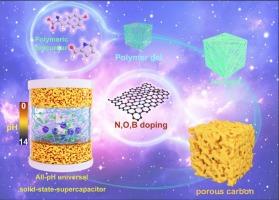N/O/B-doped phenolic resin-based high-performance porous carbon materials for supercapacitor applications
IF 4.1
3区 化学
Q1 CHEMISTRY, ANALYTICAL
引用次数: 0
Abstract
Supercapacitors have been extensively studied for their excellent power density and cycle life, but they are limited by low energy density. This study successfully prepared nitrogen/oxygen/boron (N/O/B) co-doped phenolic resin-based porous carbon materials (NBC) through a sol-gel method combined with high-temperature carbonization and activation processes, and systematically investigated their electrochemical performance in supercapacitors. By adjusting the amount of boric acid and the carbonization temperature, the pore structure and heteroatom doping levels of the materials were optimized. Experimental results demonstrate that when the carbonization temperature is 700 °C and the mass ratio of L-tyrosine to boric acid is 1:1, the obtained sample NBC-700-1 exhibits a high specific surface area (1721 m2 g−1), an abundant micro/mesoporous hierarchical structure, and uniform N/O/B doping (N content: 8.31 at.%, O content: 14.11 at.%, B content: 0.55 at.%). In a three-electrode system, NBC-700-1 (377 F g−1) exhibits superior specific capacitance, high rate performance (73% capacitance retention at 20 A g−1), and long cycle stability at 0.5 A g−1 in 6 M KOH electrolyte compared to NBC-600-1 (300 F g−1), NBC-700-0.5 (290 F g−1), NBC-700-2 (268 F g−1), and NBC-800-1 (351 F g−1). Furthermore, a symmetric supercapacitor assembled with Na2SO4 gel electrolyte achieves an energy density of 29.9 Wh kg−1 at a power density of 550 W kg−1, along with broad temperature adaptability (−25 to 75 °C) and remarkable flexibility (no significant performance degradation after 180° bending). Additionally, the design of a PVA-based gel electrolyte with wide pH applicability provides new insights for the application of such devices in complex environments.

超级电容器用N/O/ b掺杂酚醛树脂基高性能多孔碳材料
超级电容器以其优异的功率密度和循环寿命得到了广泛的研究,但能量密度低是其发展的瓶颈。本研究通过溶胶-凝胶法结合高温碳化和活化工艺成功制备了氮/氧/硼(N/O/B)共掺杂酚醛树脂基多孔碳材料(NBC),并系统地研究了其在超级电容器中的电化学性能。通过调整硼酸用量和炭化温度,优化了材料的孔隙结构和杂原子掺杂水平。实验结果表明,当炭化温度为700℃,l -酪氨酸与硼酸的质量比为1:1时,得到的样品NBC-700-1具有较高的比表面积(1721 m2 g−1)、丰富的微孔/介孔分层结构和均匀的N/O/B掺杂(N含量为8.31 at)。%, O含量:14.11 at。%, B含量:0.55 at.%)。在三电极系统中,与NBC-600-1 (300 F g−1)、NBC-700-0.5 (290 F g−1)、NBC-700-2 (268 F g−1)和NBC-800-1 (351 F g−1)相比,NBC-700-1 (377 F g−1)在6 M KOH电解质中表现出优越的比电容、高倍率性能(20 a g−1时73%的电容保持率)和0.5 a g−1的长循环稳定性。此外,用Na2SO4凝胶电解质组装的对称超级电容器在550 W kg - 1的功率密度下获得了29.9 Wh kg - 1的能量密度,同时具有广泛的温度适应性(- 25至75°C)和卓越的灵活性(180°弯曲后没有明显的性能下降)。此外,具有广泛pH适用性的pva基凝胶电解质的设计为此类器件在复杂环境中的应用提供了新的见解。
本文章由计算机程序翻译,如有差异,请以英文原文为准。
求助全文
约1分钟内获得全文
求助全文
来源期刊
CiteScore
7.80
自引率
6.70%
发文量
912
审稿时长
2.4 months
期刊介绍:
The Journal of Electroanalytical Chemistry is the foremost international journal devoted to the interdisciplinary subject of electrochemistry in all its aspects, theoretical as well as applied.
Electrochemistry is a wide ranging area that is in a state of continuous evolution. Rather than compiling a long list of topics covered by the Journal, the editors would like to draw particular attention to the key issues of novelty, topicality and quality. Papers should present new and interesting electrochemical science in a way that is accessible to the reader. The presentation and discussion should be at a level that is consistent with the international status of the Journal. Reports describing the application of well-established techniques to problems that are essentially technical will not be accepted. Similarly, papers that report observations but fail to provide adequate interpretation will be rejected by the Editors. Papers dealing with technical electrochemistry should be submitted to other specialist journals unless the authors can show that their work provides substantially new insights into electrochemical processes.

 求助内容:
求助内容: 应助结果提醒方式:
应助结果提醒方式:


